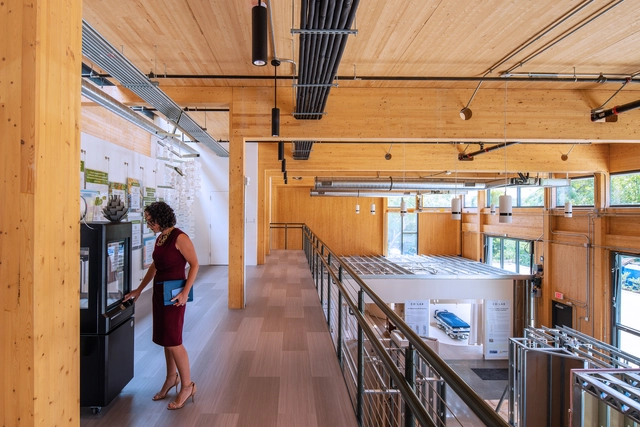
-
Architects: Robert Gurney Architect
- Area: 7284 ft²
- Year: 2021
-
Manufacturers: C.R. Laurence, Dornbracht, Western Window Systems, American Fiber Cement, FSB Franz Schneider Brakel, +12



The historical Roman town has been busy at work and new exciting buildings, squares, and public parks have bloomed across the city. Since my first trip to Zürich in 2014, a lot has happened around good old Turicum.
After a compelling trip organized by Visit Zürich and my friend Philipp Heer, we were able to visit some of the newest, most interesting and uplifting places of the city. Flitting hither and thither, Roc Isern, David Basulto, and I enjoyed the privilege of a tailored itinerary, access to Zürich's gems, and perhaps the most inspiring, the architects behind these amazing structures.


In the hilly landscape of Blumenau, a city located in the state of Santa Catarina, in southern Brazil, stands a gem of modern religious architecture by Gottfried Böhm, who recently passed away at the age of 101: the Mother Church of São Paulo Apóstolo, built from 1953 to 1963.
The São Paulo Apóstolo Church was built before the São Luiz Gonzaga Church in Brusque - two religious temples designed by Böhm with the office he inherited from his father, the architect Dominikus Böhm (1880-1955).


Rich in symbolism and tradition, religious architecture has always been marked by the grandiosity and extravagance of its interior spaces. For the architects and designers who created these spaces, everything from the scale, to the materials, to the lighting were tools to be used in optimizing their form and function and creating a place for users to connect with their faith.

We are in an unholy mess. It is a pandemic, with insane politics, and centuries of hideous racial injustice screaming out humanity’s worst realities. Each day reveals more disease, more anger, more flaws in our culture than anyone could have anticipated.
This season’s inscrutable fears are uniquely human. The natural world flourishes amid our disasters. But architecture is uniquely human, too. Architecture’s Prime Directive is to offer up safety. So in this time of danger, it is a good idea to think about the flip side of so much profane injustice and cruelty, Sacred Space? Architecture can go beyond playing it safe and aspire to evoke the best of us, making places that touch what can only be defined as Sacred.
What is Sacred Space? Whether human-made or springing from the natural world, Sacred Space connects us to a reality that transcends our fears. The ocean, the forest, the rising or setting sun may all define “Sacred”. But humans can make places that hold and extend the best in us beyond the world that inevitably threatens and saddens us. Architecture can create places where we feel part of a Sacred reality.

The largest pilgrimage church in Sicily, The Sanctuary Basilica of Our Lady of Tears in Syracuse was built to commemorate the 1953 miraculous tearing of a plaster effigy representing the Virgin Mary. The ever-growing number of religious devotees prompted the construction of a dedicated church of an appropriate scale. In 1957, an architecture competition was organized for the design of the new church, where 100 architects from 17 countries participated. The winners were Michel Andrault and Piere Parat, and their sculptural design became not only a landmark for the region but a trailblazer for religious architecture at the time.


Architecture can be understood through many prisms but is often seen solely as the response to material demands - housing, leisure, commerce, etc. But perhaps no space is more emotionally and symbolically loaded than that of sacred spaces. Designing spaces for worship (religious or otherwise) can be one of the most creative and liberating tasks of this profession. These spaces transcend the terrestrial plane of mere material to become part of a universe of subjectivity and faith.
We present below a series of illustrations of such spaces by André Chiote, featuring famed architectural works by designers such as Gottfried Bohm, Oscar Niemeyer, and Peter Zumthor.

Photographer Stefanie Zoche of Haubitz-Zoche has captured a series of vibrant images showcasing the “hybrid modernism” churches of the Southern Indian region of Kerala. The images below, also available on the artist’s website, depict the blend of modernist influences and local architectural elements that defined many Indian churches following the country's 1947 independence.
As Zoche explains, the post-independence Indian church establishment sought to differentiate itself from the historic colonial building style, and hence drew inspiration from the modernist icon Le Corbusier. The buildings in Zoche’s gallery often display an “effusively sculptural formal language and a use of intense color” with Christian symbols “directly transposed into a three-dimensional, monumental construction design.”

In his latest photographic collection, Federico Scarchilli captures Cistercian order in the form of Abbazia di Fossanova, Casamari, and Valvisciolo. Simple and utilitarian, Cistercian architecture reflects the transition between the Romanesque and Gothic periods. During this time, many religious authorities felt excessive ornamentation was a distraction to spiritual studies.

Located on a hill in Mauer, on the outskirts of Vienna, the Wotruba Church was the culmination of sculptor Fritz Wotruba’s life (the project’s architect, Fritz G. Mayr, is often forgotten). Constructed in the mid-1970s, Mayr completed the project one year after Wotruba’s death, enlarging the artist’s clay model to create a functional walk-in concrete sculpture. As can be seen in these images by Denis Esakov, the result is a chaotic brutalist ensemble that toys with the boundaries between art and architecture.
Berlin is city in which the past and the present often collide – a phenomenon particularly acute when it comes to the built environment. In this project by Japanese architect and artist Riku Ikegaya, the interior of St. Elisabeth-Kirche (Church of St. Elizabeth)—designed by Karl Friedrich Schinkel—is transformed by means of a structural installation. Consisting of a scale model of Schinkel’s plans for the Rosentaler Vorstadt Church, the artist has composed a "three-dimensional architectural sketch."
